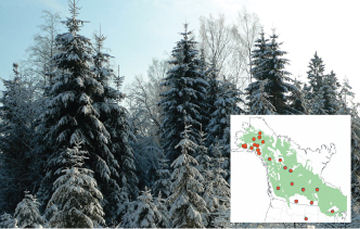Genetic analysis of white spruce trees at sites across North America suggest that that species endured the harsh climate of Alaska throughout the last ice age, a notion that scientists have debated for decades.

Picea glauca, the white spruce, is one of the most common trees in Alaska’s forests today, says Lynn L. Anderson, a plant geneticist at the University of Illinois at Urbana–Champaign. However, scientists haven’t unearthed Alaskan fossils of that species dating from the most recent ice age, which lasted from 25,000 to 12,000 years ago. During that time, most of Alaska was either a treeless tundra or covered in ice. The lack of white spruce fossils led some researchers to speculate that the species was wiped out in Alaska during the ice age and that trees from elsewhere recolonized the region once the climate warmed.
Other scientists had noted that Alaskan lake sediments from the last ice age contain trace amounts of white spruce pollen, a hint that small numbers of spruce survived. However, the grains might have blown in from distant forests.
To weigh in on the debate, Anderson and her colleagues looked at three stretches of DNA from chloroplasts, the cellular structures that produce energy in plants. The team analyzed 326 samples taken from white spruce trees at a dozen sites in Alaska and a dozen sites elsewhere in North America.
Overall, the team identified 17 combinations of genetic variations in the samples that they analyzed. While five of these combinations, called haplotypes, were in trees at all sites, seven showed up only in the Alaskan samples and five appeared only in non-Alaskan trees.
The haplotype differences suggest that today’s Alaskan spruce forests arose from trees that survived locally during the ice age, says Anderson. At the rate that genetic mutation occurs in chloroplasts, it probably wouldn’t have produced seven new haplotypes in just 12,000 years, the scenario required if the species had been wiped out in the region during the last ice age.
Moreover, if today’s Alaskan white spruce trees were descended solely from those in distant forests, the genetic variations found in their chloroplasts would be a subset of the genetic diversity found in trees elsewhere. That’s not the case, Anderson and her colleagues report in the Aug. 15 Proceedings of the National Academy of Sciences.
Researchers who had suspected that small stands of white spruce survived in Alaska during the last ice age didn’t have compelling proof, says Herbert E. Wright Jr., a paleoecologist at the University of Minnesota in Minneapolis. “These findings should be convincing enough to settle the debate,” he adds.






